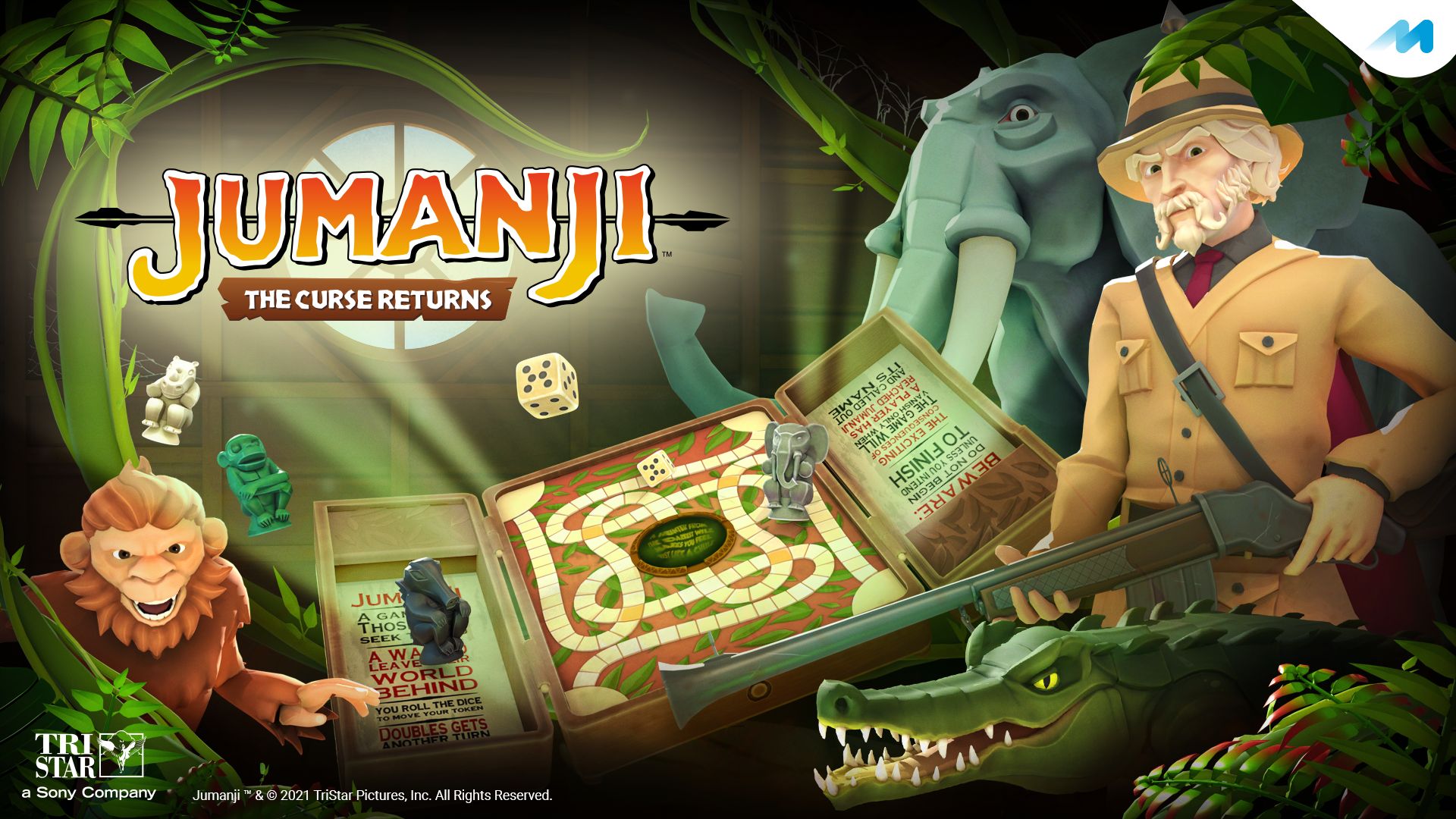Listen, Jumanji is arguably my favourite movie of all time. When I was younger, I used to joke that if I worked in a movie theatre, Jumanji would be the title film on my name tag (that is a thing for a certain big brand cinema). So it was only right for me to review this title. Marmalade Games, a popular firm known for delivering branded games to smartphone, tablet, and Nintendo Switch platforms with titles like Monopoly, Taboo, and now Jumanji: The Curse Returns, brings us this game. Marrying the original 1995 movie title ‘Jumanji’ with a card and deck building feature. This is a four player co-op adventure suitable for all ages. Lets get into it.
The game requires you to play solo with a tutorial before plunging in with friends. This seemed like an odd choice at first, because you could be playing with your family at home. It would mean everyone would have to watch you play and learn this way (which is exactly what happened in my instance) rather than having a more accessible way to play, such as advice as you went along, or asking if you need a tutorial. However, if you plan on playing with online buddies, it’s a good idea to learn the basics first.
The tutorial begins with the most essential character in the film, Alan. As you progress through your first game in the tutorial, you assume his role. Don’t worry – later on you can play as beloved characters such as Peter, Sarah and Judy as well as some other random characters if you don’t want to play as the OG’s. Because the game supports up to four people, you’ll be accompanied by three AI companions. The game appears to be authentic in appearance. With the way the characters are modelled as well as the game’s colours, it nearly reminds me of a cartoon like Netflix version of the movie.
When it comes your turn to play, you can roll the dice. Of course in true Jumanji style, a riddle will appear in the middle of the board hinting to the potential for disaster. This will take you to a location that is not just in danger, but also that the riddle indicated at what the threat might be based on the riddle. A deck of cards will now be placed in front of each player. The basic goal of this combat is to defeat your selected opponent by employing attack cards, magic cards, and team-building cards. The player’s turn ends when the battle is won or lost. If a player wins that battle, that location is secure and safe. If the battle is lost, the area becomes vine-covered and inaccessible for the rest of the game. You’ve lost Jumanji if you lose 5 battles between all players. To win the game, your token must make it to Jumanji in the centre of the board.
Metric Meters
To get into the details, each turn will allow you to fight a set number of animals or a specific type of animal. It could be an elephant stampede or a swarm of mosquitos, just like in the movie. You’ll be given a hand of cards, each of which has a distinct worth. One in the bottom corner indicates the amount of damage done or whether the card is a shield or magic card (this is also tellable with the colour of the card), and one in the left hand corner indicates how long you must wait before playing the card. This may appear confusing at first, but allow me to clarify. A meter will be placed above each player’s cards. The meter begins to fill at the start of each hand. The longer you wait till it fills, the better the card you’ll be able to play. The game also lets you delve into a bit of magic which can cause significant damage to your opponent once your magic meter fills.
When your opponent’s rage meter reaches zero, they can assault you. This can happen quickly, but you can reset the meter with a card. When it fills up, they can throw vines at you, forcing a companion to use an axe card (which can also be used as an attack card) to cut you free. The struggle will be lost if everyone becomes engulfed in vines. The rounds are more of a free-for-all where you may utilise your cards as quickly or as slowly as you want. You will also target certain foes because the game will sometimes use decoys to make you lose the battle. For example, it may indicate that you must defeat two zebras and an elephant, and that you will be given rhinos to slow you down. It may mean you have to wade through and defeat the rhinos before spawning a zebra. Because the battle is timed, players will only have a limited amount of time to complete their objective. Above each foe’s head will be a health number, allowing players to priorities who needs more attention and where to utilize their higher damage cards.
If you succeed, you will be rewarded handsomely for your efforts. This allows the user to improve their deck based on the number of coins they have accumulated throughout the game. By selecting the cards they want to play with, each player can determine their best offence or defence. After each round, players will have the choice of choosing one of three cards to add to their deck as no cards from the original deck are removed, each combat might have a wide range of outcomes. Cards range from axes, to fly swatters, to magic cards, to rope; all with the opportunity to double your damage in the store after each round if they show up.
Jungle Fever
As previously said, each combat takes place in a different area, and in keeping with the film, this is held in familiar locations such as the attic chamber, the streets, and the supermarket. Eagle eyed fans will be able to spot that the game background continues in the location you have just battled in. Another map, which is much more wintery and full of snow and ice areas that can be gobbled up by the vines for a bit of a change in background, is also available. So… that’s….about it? So far, I’ve told you about the true to life tropes that come from the original movie that fans will love, the layout of the game and the rules of combat of winning and losing. My biggest surprise was it really ends there. Each game can be quite quick in play,; and I found that playing with friends is much less challenging than playing alone. It’s so easy to win the game I had to up the difficult to ‘hard’. The differences are small in difficulty. It essentially bullet sponges your enemies in having larger health, but we could win, with not much conversation or strategy attached.
I think with a game as diverse and dynamic as Jumanji, I went away feeling a bit sad that the combat was ‘all’ of the game. Roll the dice, defeat a zebra, or a mosquito or an ‘alpha elephant’ (Alpha enemies can not be injured with attack cards and can only be damaged by magic), rinse and repeat. I anticipated that because of the game’s diversity, the dice roll would have greater depth. As Jumanji has such inventiveness with its riddles, it felt as if this wasn’t used as well as it could have been. Some combat, maybe little games like dodging a stampede, exploiting the environment around you, or other features a deck of cards could be mixed into would have lifted the game to that extra level of a ‘Jumanji’ feeling. Eventually the notorious villain Van Pelt can pay a visit in your combat, but it didn’t overally feel like I noticed him or he made a difficult difference to your objective or game round as an added enemy.
After the first time I played the game, I noticed that several of the same riddles kept popping up. I got the impression that for a game costing more than ten pounds, there would be a lot more to learn or read than what was previously covered in the first tutorial. There is also no ‘real’ strategy here, despite the fact that there could have been an intriguing strategy formula. Your card hand resets after each round, you can’t forecast or plot a strategy with your teammates, and because of the RNG, it doesn’t really matter what you do as long as you pay attention to your objective. There is an element that someone could button bash and still win the game. Games are also extremely short, running around 10-15 minutes on average. The board game itself, felt almost like a minigame. It’s well suited to mobile in this sense, but for a console like the switch it felt repetitive and too short against other popular board games in the genre. I’d seen everything a few games in, and It felt something that I wouldn’t run to jump back into any time soon. I also experienced a hard crash on my last run, half way through my second game in Hard Mode. No previous bugs had been noticed, but this would probably start to get frustrating if it kept happening. I think that if the audience is young children and families, then this is perfect. Its simple enough to grasp and short enough for small attention spans. I’m afraid this falls into the category of “would have been a nice enough game if it weren’t linked to such a large film franchise, but because it is, it feels lacklustre.” and that is a huge shame.
Repetitive, uninteresting, and lacking in substance, Jumanji: The Curse Returns contributes nothing new or dynamic to the game board genre apart from a dose of movie nostalgia. This game didn’t feel suited to the Switch console, and likely best played on a mobile device because it is short and sweet, but not much else.

Jumanji: The Curse Returns is available now on Nintendo Switch (review platform), IOS, Android and PC.
Developer: Marmalade Game Studio
Publisher: Marmalade Game Studio
Disclaimer: In order to complete this review, we were provided with a promotional copy of the game. For our full review policy, please go here.
If you enjoyed this article or any more of our content, please consider our Patreon.
Make sure to follow Finger Guns on our social channels –Twitter, Facebook, Twitch, Spotify or Apple Podcasts – to keep up to date on our news, reviews and feature
